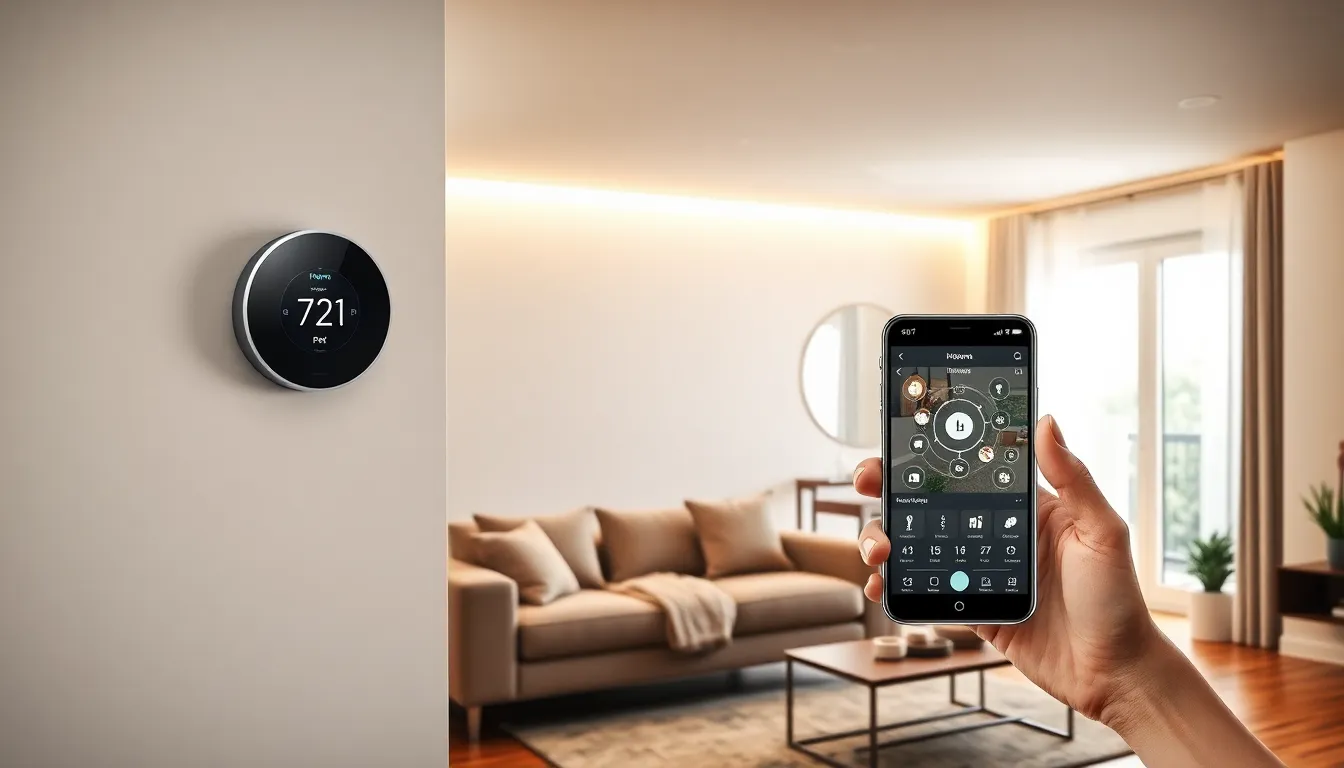Table of Contents
ToggleImagine walking into your home and having it respond to your every whim. The lights dim as you enter, the thermostat adjusts to your preferred temperature, and your favorite playlist starts playing. Sounds like a scene from a sci-fi movie, right? Well, welcome to the future of smart home systems, where convenience meets technology in the most delightful way.
Overview of Smart Home System Installation
Smart home system installation involves integrating various devices and technologies to create a cohesive and responsive living environment. Homeowners often start by assessing their specific needs and preferences. For instance, security, lighting, and temperature control frequently rank high on priority lists.
Choosing the right components plays a crucial role in installation success. Smart speakers, cameras, and thermostats are common choices. These devices connect through a central hub, allowing for seamless communication and control. Compatibility among different products remains essential to avoid functionality issues.
Installation methods vary based on the complexity of the system. Some homeowners opt for professional installation, while others choose to handle it independently. DIY installations usually require basic technical knowledge. They might involve downloading apps, following step-by-step guides, and ensuring proper network connections.
Device configuration also demands attention. Configuration includes setting up user preferences, establishing security protocols, and integrating voice control. Proper layout within the home influences user experience. For instance, placing smart devices in optimal locations enhances their effectiveness.
Routine maintenance keeps smart home systems operating smoothly. Regular software updates often improve functionality and security. Homeowners should also monitor device performance to ensure everything operates as intended. Early detection of issues can prevent larger problems down the line.
Overall, smart home system installation results in enhanced convenience and improved quality of life. Effective installation paves the way for enjoying a modern, automated home. The system’s adaptability supports changing homeowner needs, making it a valuable investment.
Benefits of Smart Home Systems

Smart home systems provide a range of advantages that enhance daily living. They boost convenience and improve energy efficiency, making homes more responsive and sustainable.
Convenience and Comfort
Smart home systems streamline various household tasks. Homeowners can control lights, temperature, and security features from their smartphones or voice assistants. Automatic adjustments based on user routines create a customized environment. For example, smart thermostats can learn preferences, adjusting temperatures when occupants are home or away. Integrated systems eliminate the need for manual adjustments. Moreover, remote access allows users to monitor their home from anywhere. This capability ensures peace of mind, especially when traveling.
Energy Efficiency
Energy efficiency is a significant benefit of smart home systems. Advanced devices like smart thermostats optimize heating and cooling, reducing unnecessary energy consumption. Homes equipped with smart lighting can automate schedules, ensuring lights turn off when not needed. Smart plugs can monitor and manage energy usage of connected appliances, providing insights that help reduce waste. According to the U.S. Department of Energy, smart home technology can decrease energy bills by as much as 20%. Overall, these systems promote sustainable living while saving homeowners money.
Types of Smart Home Systems
Smart home systems encompass various technologies that enhance convenience, security, and entertainment in homes. Understanding the different types helps homeowners choose systems that best meet their needs.
Home Automation Systems
Home automation systems streamline everyday tasks efficiently. These systems connect devices such as smart lights, thermostats, and locks, allowing centralized control through smartphones or voice assistants. Automation routines simplify life; for instance, lights can turn on or off based on occupancy. Compatibility with other smart devices enhances functionality further, enabling seamless integration across platforms. Homeowners achieve greater energy efficiency and improved comfort through customizable settings tailored to personal preferences.
Security Systems
Security systems play a crucial role in protecting homes. They typically include smart cameras, doorbells, and alarms, offering real-time monitoring and alerts. Homeowners can remotely access camera feeds through mobile devices, providing peace of mind when away. Advanced features like facial recognition enhance security by notifying residents of recognized individuals. Integration with home automation systems allows for coordinated security measures, such as locking doors when leaving or triggering alarms during unusual activity.
Entertainment Systems
Entertainment systems transform home media experiences significantly. Smart TVs, speakers, and streaming devices create immersive environments for viewing and listening. Voice control enables hands-free operation, allowing users to change channels or adjust volumes effortlessly. Integration with home automation creates synchronized systems, where movie nights can automate dimming lights and optimizing sound settings. Streaming platforms can personalize recommendations based on user preferences, enhancing viewing pleasure without complications.
Installation Process
The installation process for a smart home system requires careful planning and execution to ensure optimal functionality and integration.
Planning and Preparation
Before starting the installation, assess specific needs based on lifestyle and preferences. Security requirements often dictate the choice of devices, including smart locks and cameras. Homeowners should also consider convenience features, such as smart lights and thermostats. Carefully selecting compatible devices is vital, as they should work seamlessly with a central hub. A detailed setup plan can prevent unnecessary complications during installation. Creating an inventory of all products, tools, and instructions simplifies the process. Gathering this information beforehand allows for a smoother installation experience.
Step-by-Step Installation Guide
Starting the installation, homeowners should begin with the central hub setup, ensuring it connects to the home network. Following this, place devices in strategic locations for maximum effectiveness. For example, cameras should cover entry points while lights illuminate pathways. After positioning, homeowners need to connect each device to the hub, often following the manufacturer’s app instructions. Next, configuring device settings allows for personalization of preferences, such as temperature schedules or security alerts. Finally, testing each component ensures everything operates as intended and promotes optimal performance. Regular checks and updates will enhance overall system reliability.
Common Challenges and Solutions
Homeowners often face challenges during the installation of smart home systems. Connectivity issues rank among the most common, as devices may not communicate effectively with one another. To resolve this, choosing compatible devices with clear specifications helps ensure seamless integration.
Another frequent hurdle involves wireless signal strength. Weak signals can disrupt device performance, particularly in larger homes. Placing the central hub in a central location or using range extenders enhances Wi-Fi coverage, improving connectivity throughout the space.
Configuration problems arise when users try to set up devices without sufficient knowledge. Complexity in setting various options can lead to frustration. Following step-by-step guides or hiring a professional for assistance simplifies the process and ensures proper setup.
Compatibility issues with older devices pose additional challenges. Many homeowners possess existing technology that may not integrate with new systems. Researching available compatibility lists can help avoid purchasing incompatible devices, saving time and resources.
Security concerns also emerge during smart home installation. Homeowners often worry about unauthorized access to their systems. Implementing strong passwords and enabling two-factor authentication significantly enhances security, protecting user data and privacy.
Lastly, the continuous need for updates can challenge homeowners. Regular software updates are crucial for maintaining optimal performance and security. Scheduling automatic updates or setting reminders encourages timely maintenance, ensuring systems operate smoothly and efficiently.
Investing in a smart home system can significantly transform daily living. With the right installation approach tailored to individual needs homeowners can enjoy enhanced convenience and improved energy efficiency. By carefully selecting devices and ensuring proper configuration homeowners can create a seamless environment that adapts to their lifestyle.
Regular maintenance and updates are crucial for keeping the system running smoothly. Addressing potential challenges during installation can also lead to a more satisfying experience. As technology continues to evolve embracing smart home solutions not only adds value to a property but also elevates the quality of life for its residents.






